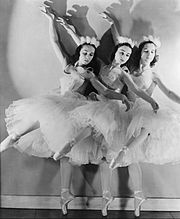Ballet Russe de Monte-Carlo

Ballet Russe de Monte Carlo was a ballet company created by members of the Ballets Russes in 1938 after Léonide Massine and René Blum had a falling-out with the co-founder Wassily de Basil (usually referred to as Colonel W. de Basil). De Basil then renamed his rival company The Original Ballet Russe.
The company
British dancers Frederic Franklin and Jo Savino were among those who joined the new company. Franklin danced with them from 1938–1952. In the 1940s, Maria Tallchief and Tamara Toumanova joined the company as principal dancers.
Blum was arrested on December 12, 1941 in his Parisian home, among the first Jews to be arrested in Paris by the French police after France was defeated and occupied by the German Nazis. He was held in the Beaune-la-Rolande camp, then in the Drancy deportation camp. On September 23, 1942, he was shipped to the Auschwitz concentration camp where he was later killed by the Nazis.
The Ballet Russe de Monte Carlo toured chiefly in the United States after World War II began. The company introduced audiences to ballet in cities and towns across the country where people had never seen classical dance. In 1968, the company went bankrupt. Before then, many of its dancers had moved on to other careers; a number started their own studios and many taught dance.
The company's principal dancers performed with other companies, and founded dance schools and companies of their own across the United States and Europe. They taught the Russian ballet traditions to generations of Americans and Europeans.
Among the most notable was George Balanchine's founding of the School of American Ballet and New York City Ballet, for which he created works for 40 years. Alexandra Danilova taught for 30 years in his School of American Ballet. Maria Tallchief, who was one of Balanchine's wives, danced with the New York City Ballet for years.
Roya Curie, a protégé of David Lichine and premier dancer with the Ballet Russe de Monte Carlo International, established a school in upstate New York in 1950. Other examples were Frederic Franklin, who was a director of the Washington Ballet. He still advises Dance Theatre of Harlem, as well as performing. Jo Savino formed the St. Paul Ballet in Minnesota.
Many dancers of the corps de ballet also taught and passed on the Russian traditions, establishing ballet studios across the United States. For example, in the late 1940s, Marian and Illaria Ladre set up their Ballet Academy in Seattle, where they taught students who went on to dance and teach in their turn. Students who had professional dance careers included James De Bolt of the Joffrey Ballet, Cyd Charisse, Marc Platt, Harold Lang, and Ann Reinking.
In 1994 Mrs. Illaria Ladre was among the first American dancers, choreographers and writers honored by receiving the newly established Vaslav Nijinsky Medal, sponsored by the Polish Artists Agency in Warsaw, for work carrying on the tradition of Nijinsky. Other awardees were Gerald Arpino, Ann Barzel, Oleg Briansky, Vladimir Dokoudovsky (1919–1998), Peter Ostwald, Richard Philp, Jennie Schulman, Mr. Turnbaugh, Anatole Vilzak and George Zoritch.[1]
A feature documentary about the company, featuring interviews with many of the dancers, was released in 2005, with the title Ballets Russes.
A Thousand Encores: Ballets Russes in Australia was a documentary screened on ABC Television on November 3, 2009, about the Ballet Russe de Monte Carlo's three visits to Australia between 1936 and 1940. The documentary claims that there is more footage of the Ballet Russes in Australia than anywhere else in the world. Some film was in colour, a rarity for that time.
Notes
- ^ Awards to Americans in Honor of Nijinsky, New York Times, November 26, 1994 Accessed November 15, 2007
References
- "Ballet Russe de Monte Carlo". Britannica Concise Encyclopedia. Encyclopædia Britannica, Inc. 1994-2010. Retrieved June 5, 2010 from answers.com.
{{cite book}}: Check date values in:|accessdate=(help) - "Ballet Russe de Monte Carlo". The Oxford Dictionary of Dance. Oxford University Press. 2000, 2004. Retrieved June 5, 2010 from Answers.com.
{{cite book}}: Check date values in:|accessdate=and|year=(help) - Ballets Russes, 2005 documentary
Further reading
- Garcia-Marquez, Vicente (1990). The Ballets Russes: Colonel de Basil's Ballets Russes de Monte Carlo 1932-152. New York: Alfred A. Knopf. ISBN 0-394-52875-1.
{{cite book}}: Cite has empty unknown parameters:|origmonth=,|chapterurl=, and|origdate=(help) - Sorley Walker, Kathrine (1982). De Basil's Ballets Russes. New York: Atheneum. ISBN 0-689-11365-X.
{{cite book}}: Cite has empty unknown parameters:|origmonth=,|chapterurl=, and|origdate=(help) - Anderson, Jack (1981). The One and Only: The Ballet Russe de Monte Carlo. Dance Horizons. ISBN 0-87127-127-3.
{{cite book}}: Cite has empty unknown parameters:|origmonth=,|chapterurl=, and|origdate=(help)
Reviews
External links
- Guide to Ballet Russe de Monte Carlo records at Houghton Library, Harvard University
